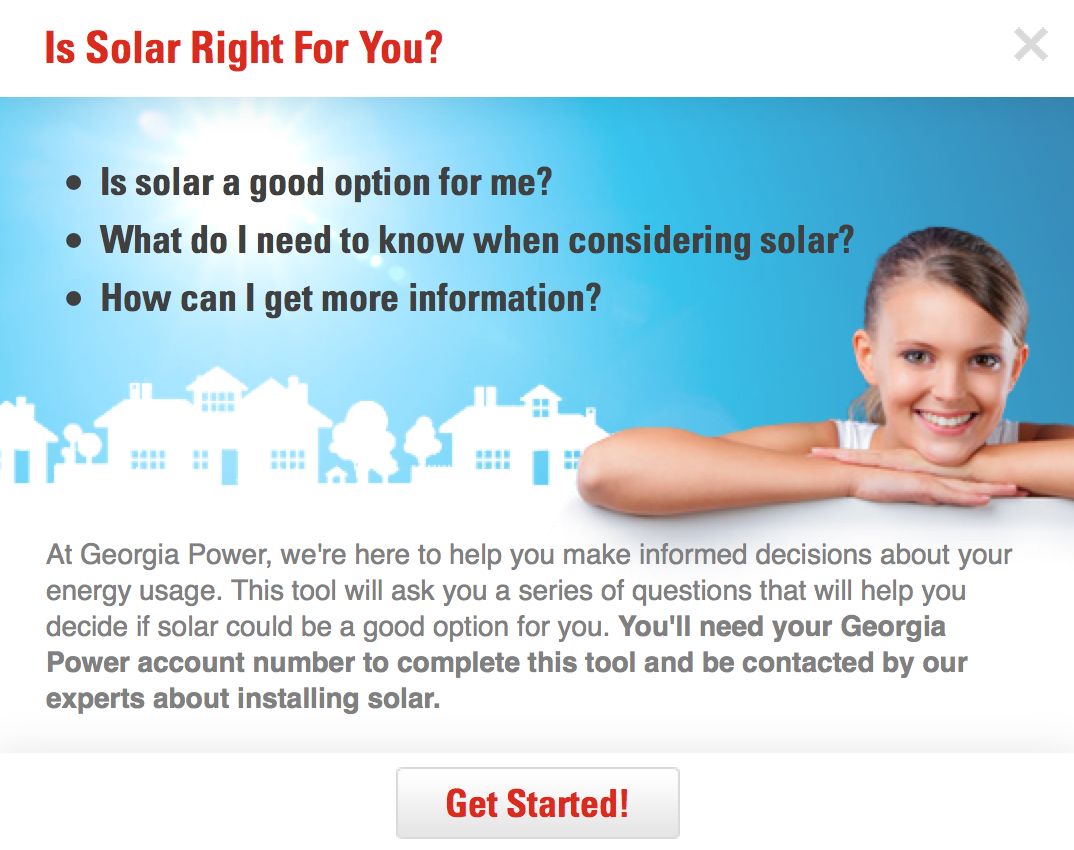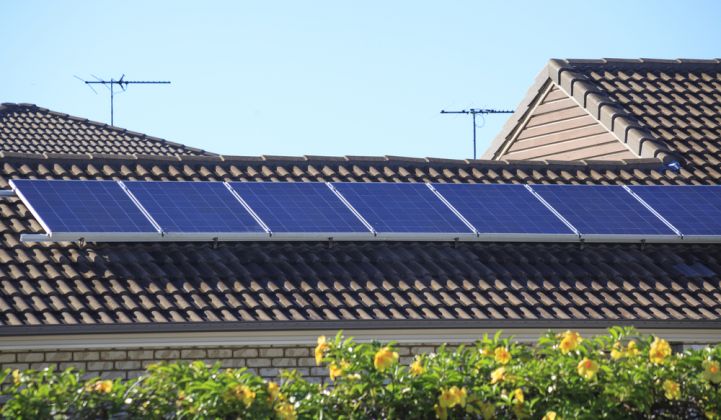For rooftop solar installers, finding customers is time-consuming and costly. For potential customers, the economics of going solar are complex and the process can be confusing.
And then there’s the utility that sits between the installers and potential solar customers with a visible brand and a very large Rolodex full of contact information. Arguably, finding a way to leverage the utility’s reputation and resources could be a win for consumers and solar companies -- and the utility, too.
Georgia Power recently announced a web portal that could be one of the first examples of a platform that serves all stakeholders.
The Southern Company subsidiary launched its enhanced rooftop solar customer assistance program on July 1, the same day that the Solar Power Free-Market Financing Act went into effect. The law allows third parties to sell solar directly to customers, opening the door for a competitive solar market. The law also gave Georgia Power the opportunity to launch its own rooftop solar business, through its unregulated subsidiary Georgia Power Energy Services.
The regulated utility’s new online portal and the new unregulated solar practice are, therefore, separate but related. How these two sides of the business interact with each other, with customers and the broader solar market cuts to the core of the debate about the utility of the future.
Reducing customer acquisition costs
Customers that use Georgia Power’s solar platform begin by completing a short survey on home ownership, shade and sun, and house size, and are provided with an estimated monthly savings and payback period. Customers who want to move forward enter their account number and contact information to request a meeting with Georgia Power’s newly hired solar specialists.
Customers sign up for a solar consultation “just like a hair appointment,” said Ervan Hancock, manager of Georgia Power's renewable implementation department, in a recent interview at Solar Power International.
“They will do a detailed analysis like any installer would do for your house and your load, and help size the best system for what will fit on your roof and makes the most economic sense,” he said.

If customers decide to move forward, they have the option of either being put in contact with Georgia Power’s unregulated subsidiary, or being directed back to the Georgia Power website to select from a list of certified solar installers.
"It’s more the regional folks that we have comfortable relationships with,” Hancock said of the utility’s list of trusted installers. “But we are in discussions with national companies as well.”
While Georgia Power doesn’t currently promote national installers on its solar portal, the utility does work with customers to gain a better understanding of their solar options regardless of which installer they choose to proceed with. This vetting service could be an enormous asset to solar companies.
“If the utility is not only taking on the burden of basically screening customers in terms of their suitability for solar, but also helping the customer generally understand what the financial options look like for them…I think that’s a really big deal,” said Julia Hamm, president and CEO of Solar Electric Power Association.
“Customer acquisition is such a big piece of cost right now for solar installers,” she continued. “I think utilities can play a significant role in driving that cost down.”
Creating a neutral platform
This is where the Georgia Power program could be appropriated to play a role in broader business-model discussions.
It’s a model where the utility would serve as a platform to enable residential solar transactions through an interactive website, in-person meetings, and marketing for all certified solar companies. In return, the utility would be able to charge a fee.
Aric Saunders, co-founder of HyGrid Energy, who’s worked as a solar EPC in Hawaii, believes getting to 100 percent renewables -- which is Hawaii’s goal -- will necessitate new business models for both utilities and solar companies.
“I think Georgia Power’s program is a pretty interesting first step,” he said.
Saunders said he has been developing a similar type of solar platform that he plans to roll out in Hawaii before the end of the year.
“Reaching customers is the hardest part [for solar installers] right now, so if you cut that loop out and the customers are just sitting there waiting, you can really drive your price down,” he said. “I can’t think of another product where people still go door-to-door to sell it. So there’s a lot of room to evolve.”
Right now, contracts are signed between solar companies and customers, and the utility remains in a silo until it receives an interconnection application. Saunders wants to bring these transactions into one silo where all parties work together.
“There’s a hesitation because the solar industry was initially about disrupting the utility,” he said. “But if you approach it from a different angle, there is a lot of efficiency we can create.”
Saunders envisions a more comprehensive solar platform that streamlines the application process, in addition to customer acquisition. The utility would offer this service to all market players, and the utility’s unregulated business arm, if indeed it has one, would have to compete among them.
The regulated utility would be compensated for this service through a flat marketing fee, a payment per acquired customer, or something else.
A potential new revenue stream?
Hamm said that the Solar Electric Power Association (SEPA) has also been grappling with this type of utility platform concept.
“There are a lot of different ways it could work. But I think utilities would have an interest in trying to monetize that service because they’re providing huge value both to the customer and the industry,” said Hamm.
“It certainly is not going to resolve all of the issues with the utility revenue model, but it could be a potential new revenue stream to offset part of the revenue loss coming from fewer kilowatt-hours being purchased,” she added.
When asked in a follow-up interview if Georgia Power plans to charge for its solar services, utility spokesperson John Kraft said the company is more focused on developing its own capabilities in the distributed energy space.
“We continue to evaluate opportunities in this new and changing area of our business; however, our first goal in the program is to be the solar expert for our customers,” he said.
Georgia Power isn’t only interested in solar. The utility’s parent Southern Company has a partnership with Tesla to test energy-storage products for commercial customers, and Georgia Power has a partnership with Nest to give away 30,000 smart thermostats to customers on time-of-use plans.
“At the end of the day, we’re looking at all of those options to support customers beyond the meter -- not just rooftop solar,” said Georgia Power's Hancock. “But certainly if a customer is interested in solar or energy efficiency, we want to make sure they know to come to us first.”
Not too different from an app store
James Tong, vice president of strategy at Clean Power Finance, has written extensively on the concept of an independent distribution system operator. Under this model, utilities operate as a neutral platform, not only for rooftop solar, but for all distributed energy resources.
Tong recently co-authored a paper on this topic with Jon Wellinghoff, former chair of the U.S. Federal Energy Regulatory Commission, as part of SEPA’s 51st State initiative.
In Tong’s view, if utilities are providing a service to third-party companies, as in Georgia Power’s solar program, they should be compensated for it.
“The model I imagine is not too different from Apple’s app store,” said Tong. “Apple hosts an app store; it brings together a bunch of providers -- in this case DER providers -- and brings together consumers. Every time you make a transaction in the app store, Apple gets a fee.”
A huge caveat is that the grid operator must be as neutral and transparent as possible, he added.
The owner of the platform can’t favor any particular resources, including its own resources. Tong admitted this is tricky. If regulated utilities continue to own and operate a centralized grid as they have been doing for decades, there is an inherent conflict of interest in allowing DER competitors to take over some of the functions utilities have traditionally performed.
At the same time, the platform owner can’t favor certain suppliers, including its own suppliers. Tong noted that Georgia Power probably wouldn't have launched a solar services program if the company wasn't able to offer solar in some way. But a utility’s regulated arm should not be able to directly influence the unregulated business, which is designed to compete in the open market.
There should be an incentive to keep the two businesses separate, Tong said, because if there’s less competition, there are likely to be fewer investments in the grid and fewer opportunities to generate revenue.
“In our world, we want unregulated subsidiaries to compete openly and fairly,” he said. “Then the question becomes what is fair. That’s what we’re trying to get at.”
Last month, Georgia Power’s unregulated subsidiary sold its first rooftop solar project via the regulated utility’s web portal. According to Hancock, thousands of people have used the online survey tool and hundreds have booked solar consultations.
How this tool ends up serving the rest of the solar market could set a precedent for a more inclusive grid model in future.



